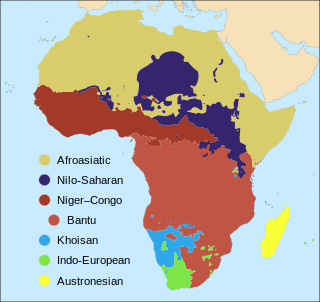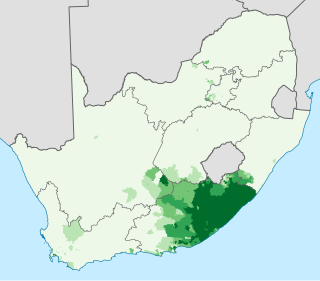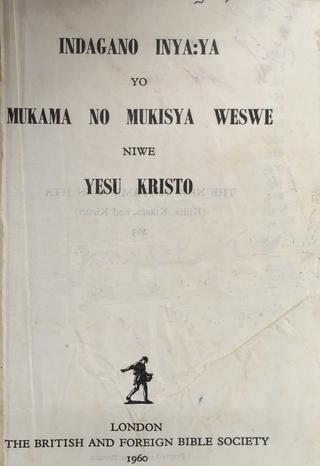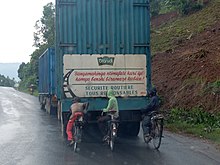Tone is the use of pitch in language to distinguish lexical or grammatical meaning—that is, to distinguish or to inflect words. All oral languages use pitch to express emotional and other para-linguistic information and to convey emphasis, contrast and other such features in what is called intonation, but not all languages use tones to distinguish words or their inflections, analogously to consonants and vowels. Languages that have this feature are called tonal languages; the distinctive tone patterns of such a language are sometimes called tonemes, by analogy with phoneme. Tonal languages are common in East and Southeast Asia, Africa, the Americas and the Pacific.
The Hutu, also known as the Abahutu, are a Bantu ethnic or social group which is native to the African Great Lakes region. They mainly live in Rwanda, Burundi and the eastern Democratic Republic of the Congo, where they form one of the principal ethnic groups alongside the Tutsi and the Great Lakes Twa.

The number of languages natively spoken in Africa is variously estimated at between 1,250 and 2,100, and by some counts at over 3,000. Nigeria alone has over 500 languages, one of the greatest concentrations of linguistic diversity in the world. The languages of Africa belong to many distinct language families, among which the largest are:

Xhosa, formerly spelled Xosa and also known by its local name isiXhosa, is a Nguni language and one of the official languages of South Africa and Zimbabwe. Xhosa is spoken as a first language by approximately 10 million people and as a second language by another 10 million, mostly in South Africa, particularly in Eastern Cape, Western Cape, Northern Cape and Gauteng, and also in parts of Zimbabwe and Lesotho. It has perhaps the heaviest functional load of click consonants in a Bantu language, with one count finding that 10% of basic vocabulary items contained a click.

Whistled languages are linguistic systems that use whistling to emulate speech and facilitate communication between individuals.
Kinyarwanda, Rwandan or Rwanda, officially known as Ikinyarwanda, is a Bantu language and the national language of Rwanda. It is a dialect of the Rwanda-Rundi language that is also spoken in Burundi and adjacent parts of the Democratic Republic of the Congo, Uganda and Tanzania. Kinyarwanda is universal among the native population of Rwanda and is mutually intelligible with Kirundi, the national language of neighbouring Burundi. Kinyabwishya and Kinyamulenge are mutually intelligible dialects spoken in the North Kivu and South Kivu provinces of neighbouring DR Congo.
Meeussen's rule is a special case of tone reduction. It was first described in Bantu languages, but occurs in analyses of other languages as well, such as Papuan languages. The tonal alternation it describes is the lowering, in some contexts, of the last tone of a pattern of two adjacent High tones (HH), resulting in the pattern HL. The phenomenon is named after its first observer, the Belgian Bantu specialist A. E. Meeussen (1912–1978). In phonological terms, the phenomenon can be seen as a special case of the Obligatory Contour Principle.
Southern Thai, also known as Dambro, Pak Tai, or "Southern language", is a Southwestern Tai ethnolinguistic identity and language spoken in southern Thailand as well as by small communities in the northernmost Malaysian states. It is spoken by roughly five million people, and as a second language by the 1.5 million speakers of Pattani and other ethnic groups such as the local Peranakans communities, Negritos, and other tribal groups. Most speakers are also fluent in or understand the Central Thai dialects.
Lisu is a tonal Tibeto-Burman language spoken in Yunnan, Northern Burma (Myanmar) and Thailand and a small part of India. Along with Lipo, it is one of two languages of the Lisu people. Lisu has many dialects that originate from the country in which they live. Hua Lisu, Pai Lisu and Lu Shi Lisu dialects are spoken in China. Although they are mutually intelligible, some have many more loan words from other languages than others.
Central Kilimanjaro, or Central Chaga, is a Bantu language of Tanzania spoken by the Chaga people.
Tonga (Chitonga), also known as Zambezi, is a Bantu language primarily spoken by the Tonga people who live mainly in the Southern province, Lusaka province, Central Province and Western province of Zambia, and in northern Zimbabwe, with a few in northwest Mozambique. The language is also spoken by the Iwe, Toka and Leya people among others, as well as many bilingual Zambians and Zimbabweans. In Zambia Tonga is taught in schools as first language in the whole of Southern Province, Lusaka and Central Provinces.
Ikwerre, sometimes spelt as Ikwere, is an Igbo language spoken primarily by the Ikwerre people, who inhabit certain areas of Rivers State, Nigeria. It is also the biggest Igbo language along with Ngwa in Abia State.
The Banyarwanda are a Bantu ethnolinguistic supraethnicity. The Banyarwanda are also minorities in neighboring Burundi, DR Congo, Uganda, Tanzania
Rwanda-Rundi is a group of Bantu languages, specifically a dialect continuum, spoken in Central Africa. Two dialects, Kirundi and Kinyarwanda, have been standardized as the national languages of Burundi and Rwanda respectively. These neighbouring dialects are mutually intelligible, but other dialects which are more distant ones may not be. The other dialects are spoken in the Democratic Republic of the Congo, Uganda, and Tanzania; Ha, with one million speakers, is the most widely spoken.

Jita is a Bantu language of Tanzania, spoken on the southeastern shore of Lake Victoria/Nyanza and on the island of Ukerewe.
Naki, or Munkaf, is an Eastern Beboid language of Cameroon and Nigeria. There is no name for the language; it is known by the villages it is spoken in, including Naki and Mekaf (Munkaf) in Cameroon and Bukwen and Mashi in Nigeria, the latter listed as separate languages by Ethnologue, though they are not distinct.
Ruuli is the Bantu language spoken by the Baruuli and Banyala people of Uganda primarily in Nakasongola and Kayunga districts. It is closely to the Nyoro language
Aushi, known by native speakers as Ikyaushi, is a Bantu language primarily spoken in the Lwapula Province of Zambia and the (Haut-)Katanga Province of the Democratic Republic of Congo. Although many scholars argue that it is a dialect of the closely related Bemba, native speakers insist that it is a distinct language. Nonetheless, speakers of both linguistic varieties enjoy extensive mutual intelligibility, particularly in the Lwapula Province.
Proto-Bantu is the reconstructed common ancestor of the Bantu languages, a subgroup of the Southern Bantoid languages. It is thought to have originally been spoken in West/Central Africa in the area of what is now Cameroon. About 6,000 years ago, it split off from Proto-Southern Bantoid when the Bantu expansion began to the south and east. Two theories have been put forward about the way the languages expanded: one is that the Bantu-speaking people moved first to the Congo region and then a branch split off and moved to East Africa; the other is that the two groups split from the beginning, one moving to the Congo region, and the other to East Africa.

Achille Emile Meeussen, also spelled Achiel Emiel Meeussen, or simply A.E. Meeussen (1912–1978) was a distinguished Belgian specialist in Bantu languages, particularly those of the Belgian Congo, Rwanda and Burundi. Together with the British scholar Malcolm Guthrie (1903–1972) he is regarded as one of the two leading experts in Bantu languages in the second half of the 20th century.






